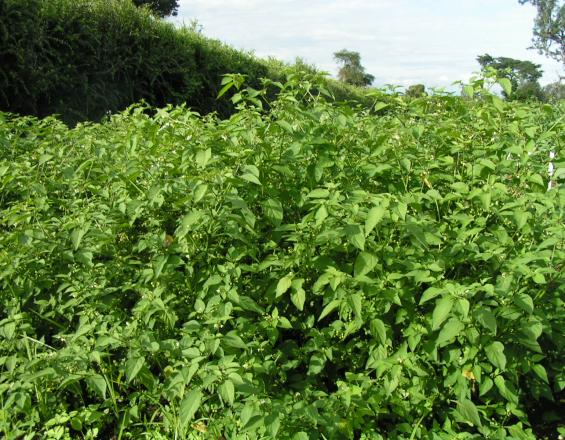
Potentiel des légumes indigènes dans le centre du Kenya

À Kirenga, Lari, dans le centre du Kenya, les précipitations faibles et irrégulières et le manque d'installations d'irrigation limitent la production de légumes. Cependant, les légumes exotiques sont cultivés dans les jardins potagers, alors que les légumes indigènes riches en nutriments sont rarement produits ou consommés. La consommation de légumes est limitée malgré la présence de malnutrition chez les enfants et les femmes. En outre, les légumes indigènes ont un marché tout trouvé à Nairobi, qui se trouve à environ 50 km. Par conséquent, la production de légumes indigènes améliorerait les moyens de subsistance de ces agriculteurs en générant des revenus, tandis que la consommation de ces légumes améliorerait leur état nutritionnel.
Pour ce faire, les agriculteurs ont été formés aux techniques de culture de ces espèces indigènes. En outre, une formation sur la façon de préparer et de consommer les légumes a été proposée. Les activités comprenaient également une sensibilisation à la valeur nutritionnelle de ces légumes afin d'encourager leur consommation par les agriculteurs locaux et leurs familles.
Traiter
Résumé du processus
Tout d'abord, vous devez communiquer efficacement avec la communauté locale sur ce que vous êtes sur le point de faire et sur les avantages qu'elle en retirera. Une fois qu'ils ont adhéré à votre idée, vous devez les impliquer dans la planification et la mise en œuvre du projet.
Blocs de construction
caractérisation participative des ressources génétiques
Grâce à la caractérisation participative avec les agriculteurs, les chercheurs sont en mesure d'effectuer la meilleure sélection d'un génotype de culture donné. Le chercheur et les bénéficiaires potentiels (principalement des agriculteurs) plantent et gèrent les cultures ensemble, puis les caractérisent selon des critères convenus d'un commun accord. La meilleure solution consiste à cultiver la plante dans le champ de l'agriculteur et à la gérer selon les pratiques de l'agriculteur.
Facteurs favorables
Confiance entre les chercheurs et les agriculteurs.
Intérêt des agriculteurs pour les travaux des chercheurs.
Leçon apprise
Avant de lancer le projet, il est important de mener une enquête afin de se faire une idée des besoins de la communauté locale ; les besoins doivent être exprimés par la communauté. Cela garantit l'adoption et la durabilité des nouvelles idées et interventions.
Nécessité de communiquer sur les avantages potentiels
Il est important d'expliquer explicitement les avantages de la nouvelle intervention. En effet, les parties prenantes (principalement des agriculteurs) sont occupées et ne vous écouteront que si elles voient dans votre entreprise des avantages monétaires ou sociaux.
Facteurs favorables
travailler avec les dirigeants de la communauté locale
utiliser un langage facilement compréhensible par la communauté locale
Leçon apprise
Ne prenez pas les parties prenantes pour acquises ; respectez-les, leur temps, leurs coutumes et leur culture.
Impacts
La National Genebank of Kenya, dans le cadre de ses activités visant à promouvoir la conservation à la ferme des ressources génétiques sous-utilisées, a encouragé la production, la consommation et la commercialisation d'ALV dans la région du Kenya central, en collaboration avec d'autres parties prenantes.
en collaboration avec d'autres parties prenantes. Nous avons commencé par sensibiliser les gens à la valeur nutritionnelle de ces légumes, puis nous les avons formés à la culture, à la consommation et à la commercialisation de ces légumes. En conséquence, certains agriculteurs ont commencé à cultiver des morelles, des moustaches de chat (Cleone gynandra) et des amaranthes et à les vendre sur les marchés en plein air. Ce sont d'abord les femmes qui se sont lancées dans cette activité, en vendant ces légumes à côté des kales et des épinards exotiques. Cela a permis d'augmenter les revenus des familles. Les familles ont également commencé à manger ces légumes indigènes et à les donner à leurs enfants, puisque nous leur avions expliqué leurs bienfaits pour la santé. Cela a amélioré leur état de santé car la plupart des familles de cette région sont pauvres en ressources et les jeunes enfants et les femmes en âge de procréer sont les plus touchés par la malnutrition due aux protéines, au calcium, au fer et aux vitamines A et C. Ces nutriments se trouvent en grande quantité dans les légumes à feuilles indigènes. Les femmes ont également profité de leurs manèges (chamas) pour cultiver et commercialiser collectivement ces légumes indigènes. Elles ont ainsi pu vendre aux hôtels qui avaient besoin de grandes quantités et d'un approvisionnement régulier ; les hôtels offraient un marché immédiat et de meilleurs prix.


